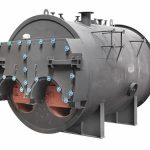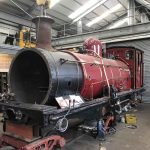THE previously described boilers, having the water outside the tubes and contained in an outer shell or so-called tank, are technically called ‘water-tank’ boilers, to distinguish them from the class known as ‘water-tube’ boilers described below.
‘Water-tube’ boilers are those in which the flame and water in the older form of boiler are interchanged, so that the water being evaporated is contained inside the tubes, and the hot gases outside them. The hot gases outside the tubes are confined and led to the funnel by a casing fitted for the purpose.
The desire to obtain boilers having the capacity of safely generating steam of higher pressures than had been previously used, combined with lightness of construction, and having the tube ends favourably situated for resisting leakage, has led engineers for many years to seek for a satisfactory water-tube boiler.
History of water-tube boilers.
The earlier examples of the water-tube boiler fitted in the mercantile marine, commencing on the Clyde about 1857, were not successful; they generally failed owing to rapid corrosion of the tubes, combined in some cases with incrustation due to saline deposits on the water side of the tubes, from the salt water which either leaked through condensers or was admitted to supply the waste of feed-water. This incrustation was usually not readily accessible for removal.
Most of these early water-tube boilers were eventually removed and replaced by the cylindrical multitubular boilers previously described, the pressure of steam being correspondingly reduced. Later on, about 1870-75, with higher pressures, renewed attempts were made in Great Britain to obtain such boilers, but they were again unsuccessful, and for some years after this, the attempt in this country was practically abandoned. Mr. Loftus Perkins was perhaps the most successful, and the Perkins boiler and engine, with pressures of 300 to 500 lbs. per square inch, attracted considerable attention. Other of these early boilers were the Rowan, Howard, and Root types.
In France an important application of such a boiler was made in 1879, by the fitting of Belleville boilers to a despatch vessel which was employed on actual sea service to a considerable extent, and her boilers were reported to have given satisfaction, so that from this time there was a gradual extension of the use of this type in the French Navy. A cruiser launched in 1885 was the next vessel fitted with these boilers, followed in 1889 by the cruiser ‘Alger,’ of 8,000 I.H.P., and two torpedo gunboats.
Soon after this two steamers of the Messageries Maritimes Company were fitted with Belleville boilers, and as the result of the experience this company has fitted similar boilers to all their new vessels, including their largest and fastest mail steamers.
A considerable number of vessels of the French Navy have also been fitted with water-tube boilers of the Niclausse, and also of the Lagrafel and D’Allest types, and some of these have also been supplied to the French mercantile marine.
In England, in 1882. a mission steamer, and in 1885, No. 100 second-class torpedo boat, were fitted with Thornycroft water-tube boilers; and the same type was fitted in three first-class torpedo boats for the Indian Government in 1888; in the torpedo gunboat ‘Speedy,’ of 4,500 I.H.P., tried in 1893; and in several foreign vessels.
In 1893, Belleville boilers were ordered to replace the defective locomotive boilers of ‘Sharpshooter.’ It being recognised that these boilers had passed out of the experimental stage, it was subsequently decided to fit the ‘Powerful’ and ‘Terrlble.’ large cruisers each of 25,000 I.H.P., with them, and subsequently all large new vessels for the British Navy have similar boilers, including (up to 1899) 27 cruisers of 10,000 to 30,000 I.H.P., and 16 battleships of 13,500 to 21,000 I.H.P., besides gunboats and other vessels.
In England the Babcock and Wilcox water-tube boiler, previously fitted in some small vessels, was fitted and tried in 1893 in the s.s. ‘Nero,’ and some other mercantile vessels have since been fitted with this type. They have also been fitted to H.M.S. ‘Sheldrake,’ (see sister-ship HMS Skipjack below) which vessel passed through all her contract trials satisfactorily, and also in several vessels of the U.S. Navy, the performance of which during the war with Spain was very satisfactory.

HMS Skipjack (Photo Ships)



Comments are closed